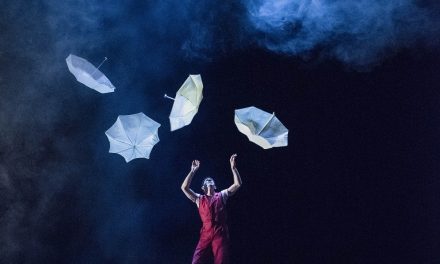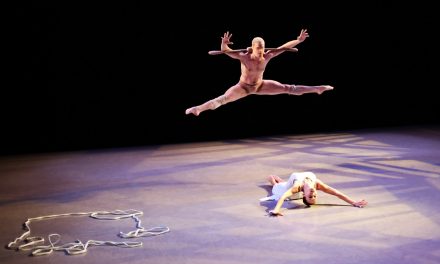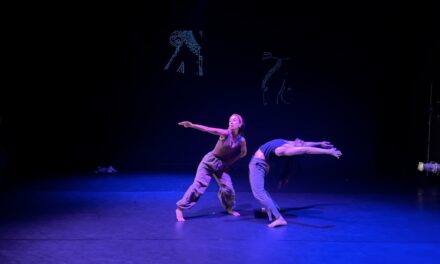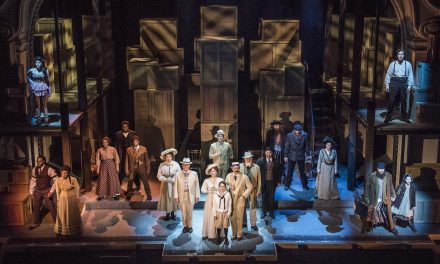GENRE! Genre? Genre…
The five performers of Will Rawls’ “[siccer]” at REDCAT foraged through the stage. They looked through a field of green film equipment (greenscreen included), calling out for Genre, a seemingly ethereal yet very real being who would have the answers to their film shoot. Is it translucent? Opulent? No one is completely sure. However, one thing is for certain: it only opens even more questions.
“[siccer]” is a part immersive installation, part live performance project by Rawls that uses dance, photography and sound to investigate the role media has in shaping and exploiting Black bodies. He does this by experimenting with stop-motion and dance, questioning what happens between the photographs. The title of the piece derives from the Latin adverb “[sic],” which indicates incorrect spelling within a quotation, often employed on Black vernacular speech. The project uses the adverb to reflect on how Black performance distances itself from Western correctness, constantly evolving and innovating. In conjunction with an exhibition at the Institute of Contemporary Art, Los Angeles, the three-day presentation at REDCAT dug deeper into the intersection of identity and technology. Rawls presents a series of questions about genre, Blackness and performance. Each holds valuable weight in “[siccer],” but they slip away as the group introduces tension without a clear foe on the other end of the fight. Rawls presses a button on a remote. The camera downstage starts clicking, taking a photo with each snap. The intention of the work quickly sets in. The five performers —Holland Andrews, keyon gaskin, jess pretty, Katrina Reid, and Jeremy Toussaint-Baptiste —pose with precision and a smile while the rush between each camera click shows an authentic version of themselves, commenting on the façade Black performers create in front of the camera to appease white viewers. The work innovates with theatrics, turning green panels into TV screens and set elements to shift from a swirling storm to a newscast. Rawls explains that “[siccer]” takes inspiration from American cinema, pulling references from movies like “Set It Off” and “Holes.” It’s a hodgepodge of cinematic history. Rawls perfectly sets the tone of the work, but then things change when everyone brings up the missing genre. They identify it as a frog and a chandelier, but even that doesn’t satisfy their search. They move on. The tug-and-pull between the performers introduces a comedic segment in the piece, showcasing each performer’s personality. Andrews and Toussaint-Baptiste have the most dynamic deliveries. Andrews’ facial expressions in front of the camera are bold and well-timed in an argument. Toussaint-Baptiste is a pro at comedic timing, delivering a quip or aside at the most opportune moments. The duo also spends time behind music equipment, transitioning scenes with improvised music created with prompts like “Greenland” or “Aurora Borealis.” The other performers groove and dance to their creations, turning the search into a party. As a theatrical element, the musical interludes are exciting additions that layer the movement happening on stage. “[siccer]” reaches its peak when Toussaint-Baptiste introduces himself as a character akin to Kermit the Frog. He sings “It’s Not Easy Being Green.” The transition to the song is heartfelt. Reid steps out in all green, putting movement to his serenade. She moves like she’s on the moon, taking soft and slow steps. It’s introspective and hopeful atop Toussaint-Baptiste’s song about the challenges that come with the color of his skin. Reid picks up a ladder and twirls with it. gaskin enters with their own dance. Their movement is mesmerizing. They have a beautiful balance between an urgent step and a smooth float. Together, the trio creates a beautiful collision and tension. But that tension soon releases its hold as the conflict shifts from racial struggles to a fight against Rawls himself — an unexpected turn. Rawls began the work by stating that a dance that goes too long is torture. The piece, billed with a runtime of approximately one hour, ran for about two. I wouldn’t go as far as to say it was torture. It very much was not but there’s something meta at play here that may provide insight into the direction of “[siccer].”The work has plenty of ideas and questions about genre, Blackness (or greenness), and money. However, the throughline between each is a bit fuzzy and leads to some prolonged segments. The show ends abruptly as the quintet of performers turn on Rawls (as the Wizard of Oz) and asks for more money. A commentary on the price of creating new work surfaces. He even expressed at the beginning and end of the work that “[siccer]” is still being developed and evolving. This requires more money. The shift brought up a much-needed conversation about funding artists, but it lets the rest of his introspection on film and Black media representation get forgotten. There is still space for this conversation about financial burdens, it simply needs the same container as the cinematic one we started with.
As the characters argue with Rawls, there is an additional concern posed: Who is the real enemy? Is it the media? Is it Rawls? Is it funding entities? The constant switch-up makes it difficult to side with the performers for their cause. There is no goal to follow. What is their need? In fact, what happened to genre? Is it to be sold, discovered or created?Genre? GENRE!! Genre…
Perhaps the future evolution of “[siccer]” will find it.
For more information about Will Rawls, please visit his website.
For more information about REDCAT, please visit their website.
Written by Steven Vargas for LA Dance Chronicle.
Featured image: “[siccer]” by Will Rawls – Photo by Angel Origgi, REDCAT.

![In search of genre in Will Rawls’ ‘[siccer]’](https://www.ladancechronicle.com/wp-content/uploads/2025/04/siccer-694-c1-1280x640.jpg)
!["[siccer]" by Will Rawls - Photo by Angel Origgi, REDCAT.](https://www.ladancechronicle.com/wp-content/uploads/2025/04/Screen-Shot-2023-12-12-at-08.59.39-1024x551.png)
![Cast of "[siccer]" by Will Rawls - Photo by Angel Origgi, REDCAT.](https://www.ladancechronicle.com/wp-content/uploads/2025/04/siccer_9-1-scaled-1-1024x577.jpg)
!["[siccer]" by Will Rawls - Photo by Angel Origgi, REDCAT.](https://www.ladancechronicle.com/wp-content/uploads/2025/04/Photo-by-Angel-Origgi--1024x683.jpg)
!["[siccer]" by Will Rawls - Photo by Angel Origgi, REDCAT.](https://www.ladancechronicle.com/wp-content/uploads/2025/04/162A0980-1024x683.jpg)
!["[siccer]" by Will Rawls - Photo by Angel Origgi, REDCAT.](https://www.ladancechronicle.com/wp-content/uploads/2025/04/siccer-69-1024x684.jpg)
![[siccer] by Will Rawls - Photo by Angel Origgi, REDCAT.](https://www.ladancechronicle.com/wp-content/uploads/2025/04/siccer-552-1024x684.jpg)





